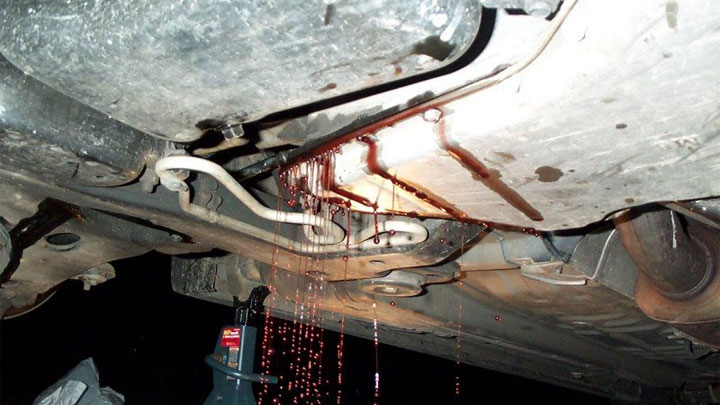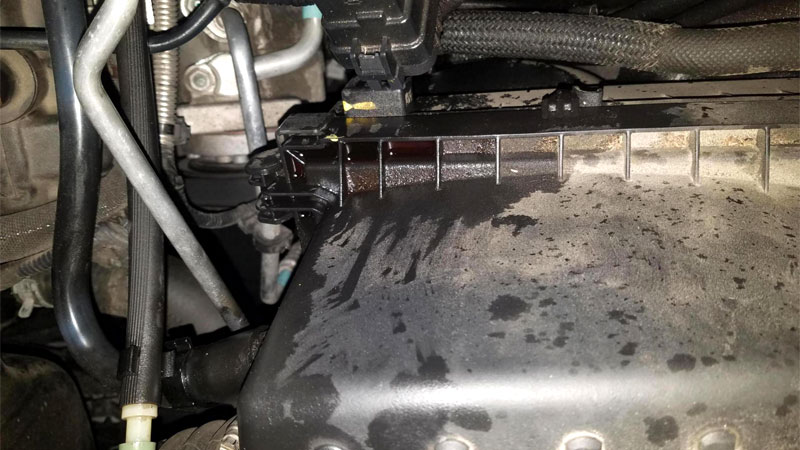Transmission fluid can leak from a variety of locations in the transmission system. The most common sources are seals and gaskets, which can wear out over time or become damaged due to extreme temperature changes. Additionally, loose drain plugs or worn-out valve body components can lead to leaks.
If there is a crack in the housing itself, this could be another potential source of leakage. Transmission lines may also develop cracks as they age or due to sudden impacts like potholes on the road. Lastly, if the transmission case is not properly sealed during reassembly after servicing it, fluid can escape through that area as well.
Transmission fluid is a critical component of your vehicle’s overall performance, so it’s important to be aware of potential signs that you may have a transmission fluid leak. Common locations where this type of leak can occur include the radiator, oil pan gaskets, seals and O-rings, dipstick tube seal, speedometer cable housing and bell housing. If any of these areas become cracked or damaged due to age or wear and tear, then transmission fluid may begin to seep out from them.
Fortunately there are ways to diagnose and repair a transmission leak before serious damage occurs.
Puddle Under Your Car or Truck? How to Diagnose Transmission Leaks
Where is the Most Likely Area for a Transmission to Leak?
The most likely area for a transmission to leak is the seals. These seals are designed to keep fluid in and dirt and debris out, but when they break down or become worn out, they can cause leaks. Leaks typically occur around the axle seals, pan gasket, shift shaft seal, input shaft seal and output shaft seal.
If any of these areas are not properly sealed or maintained, it could lead to a transmission leak that needs prompt attention from an experienced automotive technician to prevent further damage.
What are the 5 Common Causes of Transmission Fluid Leaks?
Transmission fluid leaks are one of the most common causes of transmission failure and can be caused by a variety of different reasons. The five most common causes include: worn or damaged seals, loose or missing bolts, cracked hoses and lines, insufficiently tightened fill plugs, and excessive heat which can cause corrosion in components. Worn or damaged seals are usually due to age related wear as well as impacts from debris on the road.
Loose or missing bolts may have been improperly tightened during installation leading to movement over time resulting in a leak. Cracked hoses and lines typically occur when they become brittle due to extreme temperatures such as those encountered under the hood of a car that has been running for an extended period without cooling off sufficiently between trips. Insufficiently tightened fill plug is often due to improper torqueing when changing fluids or refilling after repairs have been made.
Finally, excess heat generated from certain types of transmissions (such as manual) can lead to corrosion inside components which eventually leads to leaking fluid.
How Many Places Can a Transmission Leak From?
A transmission leak can occur from several places. The most common sources of a transmission leak are the oil pan gasket, the output shaft seal, and the torque converter seals. Additionally, if there is extensive wear or damage to your vehicle’s components such as the clutch packs or bands, shift forks, bushings, planetaries, or valve body gaskets then these may also be possible causes of a transmission fluid leakage.
It is important to have any suspected leaks inspected by an expert to determine exactly where it is coming from so that an appropriate repair can be made before further damage occurs.
What Would Cause a Transmission to Leak Fluid?
A transmission can leak fluid for a variety of reasons. The most common cause is a worn or cracked seal, which allows the fluid to escape from the transmission and drip out onto the ground. Other potential causes include loose bolts, damaged gaskets and seals, a clogged oil filter, an old or contaminated fluid in the system, or even extreme temperatures that can cause components to wear down faster than normal.
In some cases, excessive vibration from engine misfiring can also contribute to leaks. If you suspect your transmission is leaking it’s important to take it into a qualified mechanic as soon as possible so they can diagnose and repair any issues before they become more serious or costly.

Credit: automotiveinstincts.com
Transmission Fluid Leak When Parked
A transmission fluid leak when parked is a serious issue that needs to be addressed immediately. If you notice your car leaking any type of fluid, especially if it appears reddish in color and has a sweet smell, this could indicate a transmission fluid leak. It’s important to get the vehicle inspected by an experienced mechanic as soon as possible, because ignoring such leaks can lead to further damage over time and may even require costly repairs or replacements.
Transmission Fluid Leaking from Front of Car
If you notice a puddle of fluid forming underneath the front of your car, it could be an indication that there is a transmission fluid leak. Transmission fluid plays an important role in keeping your vehicle running smoothly, so it’s important to have any leaks fixed as soon as possible. A qualified mechanic can help identify the source of the leak and repair it for you.
Transmission Fluid Leak Only When Running
When a vehicle’s transmission fluid is leaking only when the engine is running, it could be indicative of a more serious issue. It may be due to an internal seal failure or a loose connection in the transmission line. If left unchecked, this can cause major damage to the transmission and will require costly repairs.
To ensure that your car runs safely and efficiently, you should have any leaks promptly checked out by a qualified mechanic.
Conclusion
Overall, it is important to understand where transmission fluid can leak from in order to properly diagnose and address any potential issues or problems. In some cases, the source of the leak may be apparent right away but other times it could take some detective work. Understanding where transmission fluid leaks are typically located will help you diagnose a problem quickly so that you can get back on the road with confidence.



